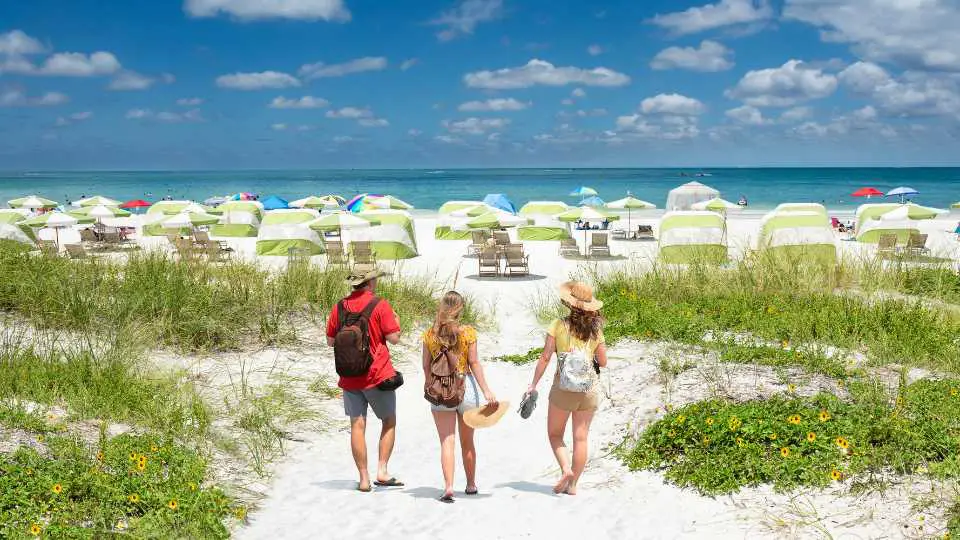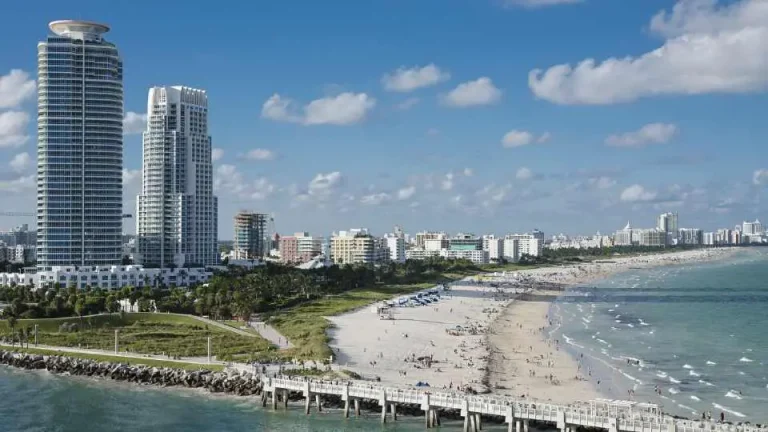The Worst Months to Visit Florida: Weather and Crowd Insights
Florida is a popular destination known for its beautiful beaches, warm climate, and vibrant culture. However, the worst months to visit are during the summer and hurricane season from June to early November. These months bring not only scorching temperatures and high humidity but also the risk of hurricanes and daily thunderstorms.
Travelers should be particularly cautious of the period from June to early November. The relentless combination of heat, humidity, and unpredictable weather can significantly affect the overall experience. Spring Break in March can also be a challenging time due to the influx of tourists, leading to crowded attractions and higher prices.
Visitors seeking a more enjoyable experience might consider alternative times between March and May or September and October. During these months, the weather is generally pleasant, and the crowds have subsided, allowing for a more relaxed visit.
Understanding Florida’s Weather Patterns
Florida experiences a range of weather patterns throughout the year. The climate is influenced by several factors including temperatures, humidity, and seasonal phenomena like hurricanes.
Summer Heat and Humidity
Florida’s summers, particularly in June, July, and August, are characterized by high heat and extreme humidity. During these months, temperatures frequently exceed 90°F (32°C) and can make outdoor activities uncomfortable.
Humidity levels are often above 70%, which can make the heat feel even more intense. It’s common to encounter daily afternoon thunderstorms, which provide brief relief but also add to the humidity levels.
Hurricane Season Insights
Hurricane season in Florida runs from June to November. The peak activity usually occurs between August and October. During these months, the state is vulnerable to hurricanes and tropical storms.
Residents and tourists should be aware of the risks and stay informed through weather updates. The Atlantic hurricane season brings the highest threats of severe weather, which includes heavy rains, strong winds, and the potential for flooding.
Winter Climate Variations
In contrast, the winter months from December to February offer a more temperate climate. Temperatures typically range from the 50s to 70s Fahrenheit (10-25°C).
Low temperatures and reduced humidity make this season more comfortable for outdoor activities. However, this period is also the peak tourist season, so accommodations can be pricier and more crowded.

Florida’s Peak and Off Tourist Seasons
Florida’s peak tourist season varies depending on the region, with notable high-traffic periods during Spring Break and summer. The off-season offers unique benefits, including fewer crowds and lower hotel rates.
Spring Break and Summer Crowds
Spring Break and summer are among the busiest times in Florida, particularly in popular destinations like Miami, Orlando, and the beaches. From March to April, droves of students and families visit, causing crowded beaches and theme parks.
Miami and other coastal areas see an influx of college students, making it difficult to find a quiet spot on the sand. In Orlando, attractions such as Walt Disney World and the Universal Orlando Resort experience heavy foot traffic, leading to long wait times for rides and attractions.
The summer months of June, July, and August mark another peak period, attracting tourists from around the world. School breaks mean that theme parks, beaches, and hotels are bustling with families. The heat can be intense, but many visitors revel in the plethora of activities and events available.
Off-Season Benefits
Visiting Florida during the off-season, primarily from May through October, provides several advantages. This low season means fewer crowds at major attractions, allowing for a more relaxed experience.
Hotel rates drop significantly during these months, offering budget-conscious travelers great value. Popular spots like the Keys, Miami, and Orlando become more affordable, and it’s easier to find dining and lodging specials.
Additionally, the weather in Florida remains pleasant, albeit hotter and more humid, giving visitors ample opportunity to enjoy outdoor activities without the hassle of peak-season congestion. Despite the increased possibility of hurricanes in late summer and early fall, the off-season remains a viable option for those looking to avoid crowds and save on travel expenses.
Avoiding Natural Events and Seasonal Discomfort
When planning a trip to Florida, it is crucial to understand the best times to avoid natural events and weather-related discomfort. The state is particularly known for its hurricane season and extreme summer weather.
Planning Around Hurricanes and Thunderstorms
Hurricane season in Florida spans from June to November, with the peak often occurring between August and September. During this time, hurricanes and daily thunderstorms are common, bringing heavy rainfall, strong winds, and the potential for significant disruptions. Travelers should avoid these months to reduce the risk of encountering severe weather.
Rainfall and electrical storms can be frequent, making outdoor activities less enjoyable and potentially dangerous. Monitoring weather forecasts and having contingency plans are essential steps if travel during this season is unavoidable.
Dealing With Extreme Summer Weather
The summer months of June, July, and August bring some of the highest temperatures in Florida. Heat and humidity during this period can reach uncomfortable levels, often exceeding 90°F (32°C), with humidity making it feel even hotter. This environment can lead to heat exhaustion and other health issues, especially for those not acclimated to such conditions.
High tourist volumes in the summer can also contribute to crowded attractions and longer wait times. For activities that involve significant outdoor exposure, early morning or late evening can be the most bearable times to visit. It is advisable to wear light clothing, stay hydrated, and take frequent breaks in air-conditioned spaces to cope with the heat.
Planning travel to Florida outside of these challenging weather periods can ensure a more comfortable and enjoyable experience.

Top Considerations for Specific Groups and Activities
When planning a trip to Florida, the timings for family vacations and pursuits such as outdoor activities and water sports are crucial. Different seasons can greatly impact your experience based on weather, crowds, and nature activities.
Family Vacations and School Holidays
Families often plan vacations during school holidays, making times like spring break and summer quite busy. Destinations such as Panama City Beach and Destin usually see high tourist traffic. These months can be crowded, expensive, and very hot, with ocean temperatures suitable for swimming.
Winter break is another popular period, offering milder weather. Palm Beach and the Florida Keys are favored for their temperate climate. However, attractions may be filled and prices can peak.
To avoid these downsides, planning trips during less busy months like September or May can provide a more relaxed experience. Florida State Parks and natural areas such as the Everglades can be less crowded and enjoyable during these off-peak periods.
Outdoor Activities and Water Sports
For those interested in outdoor activities and water sports like swimming, snorkeling, or kayaking, timing is pivotal. Summer offers warmer ocean temperatures, ideal for water-based pursuits, but also brings frequent rain and high humidity.
Spring and fall are excellent for outdoor activities. The weather is pleasant, and wildlife such as birds and manatees are more visible. National and state parks, including the Everglades, are particularly enjoyable during these seasons due to moderate temperatures and fewer pests.
Winter can be challenging for some water sports due to cooler ocean temperatures, especially in northern regions. However, southern areas like the Florida Keys often remain warm enough for snorkeling and diving.
Choosing the right time based on your specific interests can significantly enhance your Florida experience.
Regional Considerations Within Florida
Understanding the regional climates within Florida can help visitors avoid the worst months for travel, particularly when planning to visit South Florida or the Panhandle.
South Florida’s Unique Climate
South Florida experiences a tropical climate heavily influenced by the Atlantic Ocean and the Gulf of Mexico, making it prone to high humidity and tropical storms. Everglades National Park and the Florida Keys are notable areas within this region.
From June to early November, this area faces frequent rain showers and the peak of hurricane season. Heavy rainfall and potential hurricanes make travel challenging. Winter months, however, see a dry season with milder temperatures, attracting tourists looking to escape colder weather elsewhere.
The high humidity levels persist year-round, contributing to an oppressive feel during peak summer months. Miami and the Florida Keys also attract large crowds during the winter and spring breaks, making these periods less ideal for those seeking a quiet vacation.
Exploring the Panhandle Seasonally
The Panhandle, encompassing cities like Destin and Panama City Beach, presents a different set of seasonal considerations. This region drifts towards a humid subtropical climate, with distinct seasonal variations compared to South Florida. Summer months bring high humidity, extensive heat, and frequent thunderstorms.
Hurricane season still impacts the Panhandle but is less severe than it is in South Florida. Winter in the Panhandle can be chilly, especially compared to the rest of the state, sometimes dropping into the 30s °F.
Optimal times for visiting Destin or Panama City Beach include late spring and early fall, where the weather is more temperate, and the risk of storms is lower. This balance ensures a more pleasant experience with fewer indoor days due to rain and less extreme humidity.






